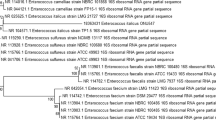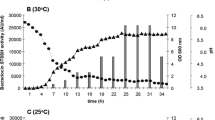Abstract
Bacteriocin producing Lactobacillus spicheri G2, isolated from Gundruk - a traditional fermented vegetable product of North East India. L. spicheri G2 identified by morphological, biochemical techniques followed by 16S rRNA gene technique. The 16Sr RNA sequence of bacteriocin producer is registered in NCBI under accession no. JX481912. The bacteriocin producing potential of L. spicheri is being reported for the first time in the present investigation. Bacteriocin of L. spicheri G2 showed strong antagonism against food spoiling and pathogenic bacteria viz. Listeria monocytogenes, Staphlococcus aureus, Clostridium perfringens, Streptococcus mutans, Lactobacillus plantarum, Leuconostoc mesenteroides and Bacillus cereus. Bacteriocin production of L. spicheri G2 was enhanced by optimization of production time, pH of medium and incubation temperature by following one variable at a time method. Maximum bacteriocin activity (2000 AU/ml) was recorded in MRS broth at 34 h with an initial pH of 4.0 after incubating at 35 °C. The bacteriocin was purified by single step gel exclusion chromatography. Molecular weight of this novel bacteriocin was determined by SDS PAGE which was found to be 43 kDa. Purified bacteriocin was found resistant to high temperature and varied pH range but sensitive to proteolytic enzymes like trypsin and proteinase k, the characters desirable for food preservation.










Similar content being viewed by others
References
Balgir PP, Bhatia P, Kaur B (2010) Sequence analysis and homology based modeling to asses structure-function relationship of pediocin CP2 of Pediococcus acidilactici MTCC 5101. Indian J Biotechnol 9:431–434
Barefoot SF, Klaenhammer TR (1983) Detection and activity of Lactacin B, a bacteriocin produced by Lactobacillus acidophilus. Appl Environ Microbiol 45(6):1808–1815
Cleveland J, Montville TJ, Nes IF, Chikindas ML (2001) Bacteriocins: safe, natural antimicrobials for food preservation. Int J Food Microbiol 71:1–2
Hata T, Alemu M, Kobayashi M, Suzuki C, Nitisinprasert S, Ohmomo S (2009) Characterization of a bacteriocin produced by Enterococcus faecalis N1-33 and its application as a food preservative. J Food Prot 72:524–530
Kandler O, Weiss N (1986) Genus Lactobacillus beijernick. 1901. Bergey’s Manual of systematic. Bacteriology 2:1209–1234
Kimura H, Sashihara T, Matsusaki H, Sonomoto K, Ishizaki A (1998) Novel bacteriocin of Pediococcus sp. ISK-1 isolated from well – aged bed of fermented rice bran. Ann. New York Acad Sci 864:345–348
Kumar R, Vadhera DV (1980) Gel permeation and ion exchange chromatography. Analytical and purification techniques in Microbiology. Lab Manual, Department of Microbiology, Punjab University, Chandigarh, p 91
Lade HS, Chitanand MP, Gyananth G, Kadam TA (2006) Studies on some properties of bacterocins produced by Lactobacillus species isolated from agro-based waste. Int J Microbiol 2:1
Lucose F, Sundar K, Shetty PH (2012) Process improvement to enhance the nutritional quality of indian fermented food (Gundruk). Int J Hum Gen Med Biotechnol Microbiol Stud 1(2):2319–1732
Motta AS, Brandelli A (2002) Characterization of an antibacterial peptide produced by Brevibacterium lines. J Appl Microbiol 92:63–70
Oh S, Kim SH, Worobo RW (2000) Characterization and purification of bacteriocin produced by a potential probiotic culture L. acidophilus 30SC. J Dairy Sci 83(12):2747–2752
Paik HD, Bae SS, Park SH, Pan JG (1997) Identification and partial characterization of Tochicin, a bacteriocin produced by Bacillus thuringeinsis subsp. tochigiensis. J Ind Microbiol Biotechnol 19:294–298
Register F (1988) Nisin preparation affirmation of GRAS status as a direct human food ingredient. Food Reg 54:11247–11251
Sharma N, Kapoor G, Neopaney B (2006) Characterization of a new bacteriocin isolated from a novel isolated strain Bacillus lentus NG 121. Antonie Van Leeuwenhoek 89:337–343
Sharma N, Kapoor R, Gautam N, Kumari R (2011) Purification and characterization of bacteriocin produced by Lactobacillus sp. A75 isolated from fermented chunks of Phaseolus radiata. Food Technol Biotechnol 49(2):169–176
Sharpe ME (1979) Identificación of the lactic acid bacteria. In: Skimmer FA, Lovelock DW (eds) Identification methods for microbiologists. Soc. Appl Bacteriol. Technical series no Academic Press, London, pp 246–255
Voet D, Voet J (2004) Three dimensional structure of proteins. Biochemistry 3rd (ed). Wiley, pp 265–268
Author information
Authors and Affiliations
Corresponding author
Rights and permissions
About this article
Cite this article
Gautam, N., Sharma, N. A study on characterization of new bacteriocin produced from a novel strain of Lactobacillus spicheri G2 isolated from Gundruk- a fermented vegetable product of North East India. J Food Sci Technol 52, 5808–5816 (2015). https://doi.org/10.1007/s13197-015-1710-x
Revised:
Accepted:
Published:
Issue Date:
DOI: https://doi.org/10.1007/s13197-015-1710-x




